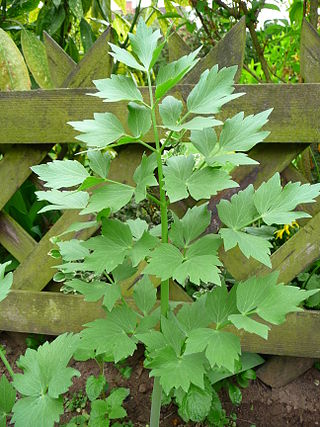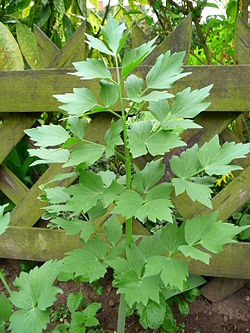Top Qs
Timeline
Chat
Perspective
Lovage
Species of flowering plant From Wikipedia, the free encyclopedia
Remove ads
Lovage (/ˈlʌvɪdʒ/ LUV-ij; Levisticum officinale) is a perennial plant, the sole species in the genus Levisticum in the family Apiaceae, subfamily Apioideae.[2][3] It is native to Afghanistan and Iran.
It has been long cultivated in Europe and the leaves are used as a herb, the roots as a vegetable, and the seeds as a spice, especially in southern European cuisine. Its flavour and smell are reminiscent both of celery and parsley, only more intense and spicier than either. The seeds can be used in the same way as fennel seeds.
Remove ads
Description

Lovage is an erect, herbaceous, perennial plant growing to 2.5 metres (8 ft) tall,[4] with a basal rosette of leaves and stems with further leaves, the flowers being produced in umbels at the top of the stems. The stems and leaves are shiny glabrous green to yellow-green and smell somewhat similar to celery when crushed. The larger basal leaves are up to 70 centimetres (28 in) long, tripinnate, with broad triangular to rhomboidal, acutely pointed leaflets with a few marginal teeth; the stem leaves are smaller and less divided, with few leaflets.
The flowers are yellow to greenish-yellow, 2–3 mm (1⁄16–1⁄8 in) diameter, produced in globose umbels up to 10–15 cm (4–6 in) diameter; flowering is in late spring. The fruit is a dry two-parted schizocarp 4–7 mm (3⁄16–1⁄4 in) long, mature in autumn.[4]
Remove ads
Taxonomy
Carl Linnaeus used the basionym Ligusticum levisticum in Species Plantarum to refer to lovage.[5] Levisticum officinale was described later by W.D.J. Koch and published in Novorum Actorum Academiae Caesareae Leopoldinae-Carolinae Naturae Curiosorum in 1824.[6]
Etymology

The name "lovage" is from "love-ache", ache being a medieval name for parsley; this is a folk-etymological modification of the older French name levesche, from late Latin levisticum, in turn thought to be a modification of the earlier Latin ligusticum, 'of Liguria' (northwest Italy), where the herb was grown extensively.[7] In modern botanical usage, both Latin forms are now used for different (but closely related) genera, with Levisticum for (culinary) lovage, and Ligusticum for Scots lovage, a similar species from northern Europe, and for related species.[7]
Remove ads
Distribution
Levisticum officinale is native to Afghanistan and Iran,[1] but has been introduced to most of Europe, and parts of Southeast Asia, North and South America.[1]
Health concerns
Lovage root contains furanocoumarins which can lead to photosensitivity.[8]
Uses
Summarize
Perspective
The leaves can be used in salads, or to make soup or season broths, and the roots can be eaten as a vegetable or grated for use in salads. Its flavour and smell are reminiscent both of celery and parsley, only more intense and spicy than either. The seeds can be used as a spice in the same way as fennel seeds.[9]
The plant has long been cultivated in Europe, the leaves being used as a herb, the roots as a vegetable, and the seeds as a spice, especially in southern Europe.[9]
- In the Netherlands, lovage leaves are traditionally cooked with white asparagus and salt[10][better source needed] and served with boiled eggs.[11][irrelevant citation]
- In Ukraine, lovage (in Ukrainian любисток/liubystok) is considered an aphrodisiac. Traditionally, an infusion prepared from lovage leaves has been used by women for rinsing their hair, in order to attract men with the pleasant spicy smell of the plant. Nowadays, hair conditioners can be bought which contain lovage extract to strengthen the hair. Lovage leaves and roots are also used in salads and as a spice in Ukraine.
- In Romania, the leaves are a preferred seasoning for the various local broths and are just as popular, in this respect, as parsley or dill.[12] Furthermore, the dried foliage and seeds are added to pickled cabbage and cucumbers both to aid in their preservation and to add flavour to them.[13]
- In the UK, an alcoholic lovage cordial is traditionally added to brandy as a winter drink and is or was popular in Cornwall where it was originally added to slightly spoiled smuggled brandy to hide the taste of salt.[14]
The roots, which contain a heavy volatile oil, are used as a mild aquaretic.[15]
Remove ads
In culture
A recommendation to cultivate lovage on the agricultural properties of Charlemagne appears in chapter 70 of Capitulare de villis, a text written around 800 AD about the maintenance of royal estates.[a][16]
Notes
- De villis vel curtis imperialibus (Of imperial lands and imperial courts). Volumus quod in horto omnes herbas habeant, id est (We want that in the garden they have all sorts of plants, that is): Lilium (lily), Rosas (roses), Fenigrecum (fenugreek or methi), Costum (costmary), Salviam (sage), Rutam (rue), Abrotanum (southernwood), Cucumeres (cucumbers), Pepones (big melons), Cucurbitas (European gourd), Fasiolum (bean, here black-eyed pea), Ciminum (cumin), Rosmarinum (rosemary), Careium (caraway), Cicerum italicum (chickpea), Squillum (squill), Gladiolum (gladiolus), Dragantea (dragon arum), Anesum (aniseed), Coloquentidas (colocynth), Solsequiam (heliotrope), Ameum (meum athamanticum), Silum (seseli), Lactucas (lettuces), Git (black cumin, nigella), Eruca alba (aragula or rocket salad), Nastursium (garden cress), Parduna (burdock), Peledium (pennyroyal), Olisatum (alexanders), Petresilinum (parsley), Apium (celery), Levisticum (lovage), Savinam (savin juniper), Anetum (dill), Fenicolum (fennel), Intubas (chicory), Diptamnum (dittany of Crete or hop marjoram), Sinape (mustard), Satureium (savory), Sisimbrium (water mint), Mentam (corn mint), Mentastrum (apple mint), Tanazitam (tansy), Neptam népite (catmint), Febrefugiam (common centaury), Papaver (poppy), Betas (Swiss chard), Vulgigina (European wild ginger), Mismalvas (marshmallows), Malvas (lavateras), Carvitas (carrots), Pastenacas (parsnips), Adripias (garden orache), Blidas (purple amaranth), Ravacaulos (kohlrabi), Uniones (onions), Britlas (perennial garlic), Porros (leeks), Radices (turnips or radishes), Ascalonicas (shallots), Cepas (Welsh onions), Alia (garlic), Warentiam (madder), Cardones (fuller's teasel), Fabas majores (broad beans), Pisos mauriscos (green peas), Coriandrum (coriander), Cerfolium (chervil), Lacteridas (caper spurge), Sclareiam (clary sage)
Remove ads
References
External links
Wikiwand - on
Seamless Wikipedia browsing. On steroids.
Remove ads

